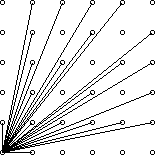Visible Lattice Points(POJ3090)
来源:互联网 发布:云之家软件 编辑:程序博客网 时间:2024/05/29 19:57
【题目描述】
A lattice point (x, y) in the first quadrant (x and y are integers greater than or equal to 0), other than the origin, is visible from the origin if the line from (0, 0) to (x, y) does not pass through any other lattice point. For example, the point (4, 2) is not visible since the line from the origin passes through (2, 1). The figure below shows the points (x, y) with 0 ≤ x, y ≤ 5 with lines from the origin to the visible points. 
Write a program which, given a value for the size, N, computes the number of visible points (x, y) with 0 ≤ x, y ≤ N.
【输入格式】
The first line of input contains a single integer C (1 ≤ C ≤ 1000) which is the number of datasets that follow.
Each dataset consists of a single line of input containing a single integer N (1 ≤ N ≤ 1000), which is the size.
【输出格式】
For each dataset, there is to be one line of output consisting of: the dataset number starting at 1, a single space, the size, a single space and the number of visible points for that size.
【样例输入】
4
2
4
5
231
【输出格式】
1 2 5
2 4 13
3 5 21
4 231 32549
【分析】
不难发现一个规律:对于n*n,可以从(0,0)连接到(n,0)到(n,n)上,斜率将会是1/n,2/n,…,(n-1)/n。
凡是分子和分母能够约分的,也就是有公约数,前面都已经有过了,所以每次添加的个数就是分子和分母互质的个数。
于是问题变成:对于正整数n,求小于n且与n互质的数的个数。这就是欧拉函数模板题了。
#include<cstdio>const int Maxn=1000;bool vis[Maxn+5];int phi[Maxn+5],p[Maxn+5];int n,ans,t;int main(){ phi[1]=1; for (int i=2;i<=Maxn;i++){ if (!vis[i]) p[++p[0]]=i,phi[i]=i-1; for (int j=1;j<=p[0] && i*p[j]<=Maxn;j++){ vis[i*p[j]]=1; if (i%p[j]==0){ phi[i*p[j]]=phi[i]*p[j];break; } else phi[i*p[j]]=phi[i]*(p[j]-1); } ans+=phi[i]; } scanf("%d",&t); int Case=0; while (t--){ scanf("%d",&n); ans=0; for (int i=1;i<=n;i++) ans+=phi[i]; printf("%d %d %d\n",++Case,n,ans*2+1); } return 0;}- Visible Lattice Points(poj3090)
- Visible Lattice Points(POJ3090)
- poj3090-Visible Lattice Points
- poj3090-Visible Lattice Points
- poj3090 Visible Lattice Points
- [POJ3090]Visible Lattice Points
- POJ3090 Visible Lattice Points
- POJ3090-Visible Lattice Points-数论
- Visible Lattice Points(Poj3090)(欧拉函数运用)
- poj3090 Visible Lattice Points(法雷级数)
- poj3090 Visible Lattice Points(欧拉函数 莫比乌斯反演)
- poj3090 Visible Lattice Points 欧拉函数的应用
- poj3090 Visible Lattice Points(莫比乌斯反演)
- Poj3090 Visible Lattice Points 欧拉函数求和
- 【POJ3090】Visible Lattice Points-欧拉函数应用
- pku3090 Visible Lattice Points
- Visible Lattice Points
- P8 Visible Lattice Points
- 前端总结·基础篇·CSS(一)布局
- kaldi NFS/GlusterFS
- 半年总结
- node爬虫进阶之——登录
- mac brew 的安装
- Visible Lattice Points(POJ3090)
- SplitContainer.SplitterDistance属性值设置
- React
- 建造者模式
- swift 属性定义 存储属性、计算属性、类属性
- Adobe 全家桶系列卸载工具
- 算法设计与应用基础作业(一)
- 【Java】JDK的环境变量配置
- 逻辑地址、虚拟地址、线性地址、物理地址


